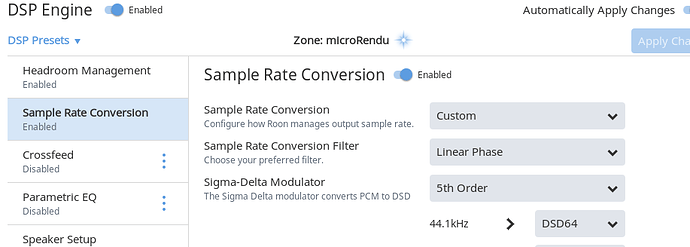Thanks Brian, that’s clearer now. One point to note, I had been trying DSD64 using the ‘Custom’ selection from the pull down menu. When doing this the ‘DSD Gain Adjustment’ is not available as a menu selection?
That looks like a bug–we’re hiding the setting inappropriately. You can work around it by temporarily setting the mode to “DSD” then setting the value you want. It will be saved/applied even if the setting is hidden in the user interface. We’ll get that fixed for the next build.
OK, and agreed, this is easy enough to work around. Once you know it’s there!
This feature is over my head. I need an “idiot’s guide” on how to use it. Too many customizations.
There’s a guide in the KB. It’s written for an intelligent person who hasn’t necessarily had a lot of DSP experience. I think you’ll find it helpful.
Thanks. That’s helpful but still the choices are a bit overwhelming. A couple of questions:
- What is the difference between Max PCM and Max PCM (Power of 2)?
- My processor ranges from 13x to 19x, I can’t tell if that is good or bad.
Edit: What are the benefits of DSP upsampling for lossy files?
Max PCM will upsample to the highest resolution supported by the DAC.
Max PCM (power of 2) will upsample to the highest resolution which is a multiple of 2 x the original resolution. This can involve fewer DSP steps.
Anything above 1.3 or so is OK. 1 = 100% CPU, 2 = 50% etc.
Noise shifting. See this recent discussion.
Ahh, Max PCM will always upsample to say, 24/192, while Power of 2 would only upsample redbook (16/44) to 24/176, right?
Edit: Does DSP up-sampling to my DAC’s max automatically make it a NOS DAC?
Most of the off selves DACs have 8x oversampling filters that are consisted of three 2x filters.
When you input data at 44.1/48k (single rate), you get all the three filters. When you input data at 88.2/96k (double rate), you get two filters. And when you input data at 176.4/192k you get only one. At 352.8/384k, you get no over sampling digital filter. In another word, at 352.8/384k, it behaves like a ‘NOS’ DAC.
Some higher speed digital to analogue stage can accept beyond 352.8/384, say 705.6/768 or even higher in the MHz range, therefore, there will be additional over sampling digital filters it have to go through until the sampling frequency is capped by the digital to analogue conversion.
The advantage of NOS DAC is it can bypass the over sampling digital filters inside the DAC chip at any input sampling frequencies and up to max it can handle. By using software up sampling like HQP and Roon 1.3, one has the flexibility on the over sampling rate and choice of digital filters. The final analogue output stage goes through a 1st order analogue LPF. Hope this helps
6 posts were split to a new topic: mR to Mutech; Roon not providing native DSD options
I have two micro rendu’s and would like to set different upsampling rates for each. I’ve done that in Roon Server, but the iPhone app shows it’s outputting the same rate to both devices?
Is what I want to do possible? Thanks.
It occurs to me that up-sampling in Roon or HQP makes a quality DAC less necessary since all that upsampling is done before it hits the DAC. This true?
Up sampling and digital filters done in software level gives user the flexibility, it doesn’t correct the conversion artifacts if the DAC is poorly designed (both in the digital to analog conversion and the analogue output stages).
So having a good quality DAC plus software up sampling can really make a lot of different.
@guy, how do you activate this feature?
The Roon KB article on the DSP Engine may assist.
Using software upsampling won’t make the power supply in the DAC any cleaner, or the clocks have any less jitter. It also has no effect on the quality of the analog filter either. All of these are an essential part of a DAC which play a critical role in the end result. It just allows use of the much more powerful processing capabilities inside a modern PC to handle the role of digital processing, opposed to the traditional method of using an ASIC chip, FPGA or DSP chip inside the DAC. However depending on how the internal digital processing is handled in the DAC, you may or may not experience any advantages. Ideally you want a DAC that does no digital processing internally whatsoever to take full advantage of software based SRC/SDM. Otherwise you end up processing the SRC/SDM twice, instead of once. In this situation the inferior SRC/SDM will only act as a bottleneck for the superior SRC/SDM. Another huge advantage is your DAC get’s continuously upgraded as the software SRC/SDM algorithm’s are upgraded. Something that’s impossible if your DAC uses ASIC chip based SRC/SDM.
Yes, totally agreed. My recent purchased of the Holo Spring NOS DAC has the ability to bypass the hardware over sampling digital filters, Doing it now on the software level means I’ve more control of it.
I have plenty of processing power so give me all that you can. 
Yes if the option of superior algorithms are there, it doesn’t mean that folks with lower powered processors are obligated to use them 
I get this screen too. Any luck figuring it out?
